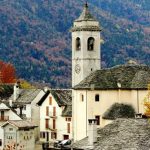The hamlets – Crana and Buttogno – have preserved all the elements of the ancient rural architecture,
the original fresco decorations and the religious buildings, which were erected thanks to the generosity of the emigrants.
In the little square of Crana you can admire a religious building that consists of two different churches connected one to the other: the Church of Saint John The Evangelist – built in the 18th century and frescoed by Giuseppe Mattia Borgnis – and the little and fascinating Oratory of Saint Roch – built as a votive offering by the population after a plague epidemic that struck the village in 1529 -1530.
The walls of this Oratory are totally decorated with frescoes. Twelve big square frescoes portray the history of Saint Roch. The church was frescoed by the Lombard painter Battista da Legnano in 1534. Unfortunately the fascinating and brilliant colours of the frescoes on the right wall faded after a restoration carried out by Luigi Morgari in 1894.
The small hamlet of Buttogno is surrounded and well protected by thick woods. The development of Buttogno followed a precise plan: in the north part of the village all the rural houses were built, while on the south side all the noble villas with their gardens were erected.
The Church is dedicated to Saint Lawrence and Saint Anthony and it was built in 1652 on the site where the ancient Oratory of 1421 stood. The church was frescoed by the painter Lorenzo Peretti (1774 – 1851). You can admire over the choir a tondo by Peretti, depicting Saint Cecilia, playing the organ.
The most precious work of this church is the oil painting by Daniele Crespi (1590-1630), representing Christ Crucified with Saint Francis from Assisi and Saint Charles Borromeo.
In the centre of this rural village, you can admire ancient stables and cowsheds made of stone, as well as noble houses, like Casa Peretti (owned by the famous painter) or Casa Simonis (a creative mixture of local architecture and Baroque style).


